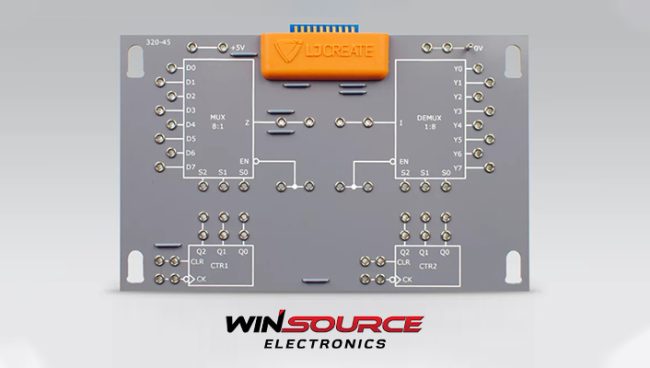
Multiplexer, also known by its “MUX” abbreviation, is a building block necessary for data communication and information processing. At its core, a multiplexer serves the critical function of selecting one from several input signals and channeling it to a singular output.
That functionality is essential in many digital applications, such as robust communication systems and data routing. Through their adeptness, multiplexers streamline resource usage, improve circuit efficiency, and minimize complexity.
But they do much more, which is why this guide goes beyond the basics, highlighting all multiplexer features, characteristics, and possibilities. Here’s what you should know about this digital electronic device before purchasing it.
What Precisely is a Multiplexer?
A hardware component with diverse applications, a multiplexer, is engineered to handle multiple inputs and selectively allow one to pass as the output. Some multiplexers go beyond and engage in both multiplexing and demultiplexing functions.
On the other hand, demultiplexing entails converting a single input into multiple output channels. A multiplexer’s strategic role lies in judiciously allocating bandwidth to enable various users or applications to share a common physical medium.
Each user receives a designated portion of the bandwidth or a specific time slot, optimizing the use of the transmission medium. Four multiplexing methods are commonly employed: space division multiplexing, frequency division multiplexing, time division multiplexing, and address multiplexing.
How Does a Multiplexer Work?
At its core, a multiplexer consolidates diverse input signals into a unified output signal. Its prowess enables multiple users or input signals to share a solitary transmission channel through the adept mechanisms of signal switching or allocating distinct time intervals to individual signals before progressing to the subsequent signal or user. This streamlined approach significantly reduces the quantity and associated costs of cables and wires essential for establishing connections. Moreover, a multiplexer facilitates data compression, minimizing the size of data packets or information.
That process helps reduce the required space or file volume to store data. Multiplexer optimizes data transmission for swift data transfer over a transmission channel. For instance, a time division multiplexer tactically divides a data packet into smaller, manageable frames. The multiplexed processes efficiently transmit their respective frames within allocated time intervals, resulting in heightened transmission capacity, diminished redundancies, and an overall enhancement in efficiency.
Different Types of Multiplexers
Multiplexers come in various types, each tailored to specific applications, ensuring versatility in meeting diverse technological needs. One classification differentiates multiplexers based on the number of inputs and outputs.
The most straightforward type is the 2-to-1 multiplexer, designed to handle two input signals and direct one to the output. This simplicity extends to larger configurations, such as the 4-to-1 and 8-to-1 multiplexers, accommodating four and eight inputs, respectively, streamlining the selection process for various data streams.
Beyond these basic structures, there are also more advanced multiplexers, such as the 16-to-1 and 32-to-1 variants, capable of managing larger datasets with precision and efficiency. These multiplexers have become invaluable in applications demanding the consolidation and routing of extensive information flows.
Another classification categorizes multiplexers based on the nature of the signals they handle. Analog multiplexers excel in managing continuous signals, ensuring seamless transmission without losing quality.
Conversely, digital multiplexers efficiently handle discrete signals, making them instrumental in various digital applications. Those seeking the best of multiplexing technology should prioritize programmable multiplexers.
These dynamic devices offer customizable configurations, allowing users to adapt the multiplexing process to their applications’ unique requirements. This flexibility empowers engineers and designers, providing a potent tool to optimize data management and enhance overall system performance.
Hence, different types of multiplexers cater to various applications, from elementary signal selection to managing intricate data streams, showcasing how multiplexing technology elevates the adaptability and efficiency of modern electronics.
Multiplexing Methods and Techniques
Within the data transmission domain, diverse multiplexing techniques play key roles in optimizing the efficiency of shared communication channels.
Time Division Multiplexing (TDM)
This method involves the sequential transmission of multiple signals over a single channel, each assigned specific time intervals. This cyclical allocation ensures the sequential accommodation of different signals, effectively utilizing available bandwidth.
Frequency Division Multiplexing (FDM)
On the other hand, this technique introduces a nuanced dimension to multiplexing. Here, multiple signals traverse a singular channel by segmenting the channel’s frequency spectrum into distinct bands.
Each band serves as a conduit for a unique signal, allowing simultaneous transmission without interference. FDM excels in maximizing frequency space, facilitating the amalgamation of diverse signals over a shared channel.
Wavelength Division Multiplexing (WDM)
Unlike others, this method extends multiplexing capabilities into the optical domain. Predominantly used in fiber-optic communications, WDM assigns unique wavelengths of light to multiple optical signals transmitted through a single optical fiber.
By utilizing distinct wavelengths, WDM enables simultaneous and independent transmission of various signals, enhancing the capacity and efficiency of optical communication systems.
These multiplexing techniques underscore the adaptability of multiplexers in orchestrating the seamless coexistence of diverse signals over shared communication channels, contributing significantly to the optimization of data transmission in various applications.
A multiplexer in digital electronics offers various benefits, including simplified circuit design, efficient resource utilization, fast switching, and cost-effectiveness. Whether you need to select and direct signals or manage extensive datasets, multiplexers can get the job done.
WIN SOURCE, a comprehensive and reliable electronic components distributor, collaborates with many manufacturers to help you find a multiplexer that matches your needs. Contact us for more information and elevate your project with a multiplexer that can handle every function and requirement.
© 2025 Win Source Electronics. All rights reserved. This content is protected by copyright and may not be reproduced, distributed, transmitted, cached or otherwise used, except with the prior written permission of Win Source Electronics.

COMMENTS